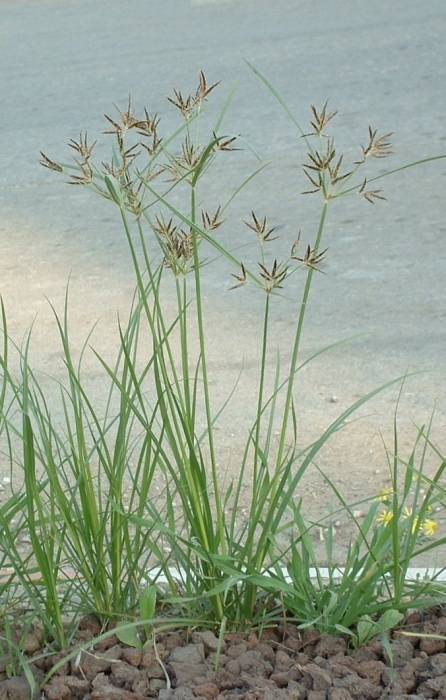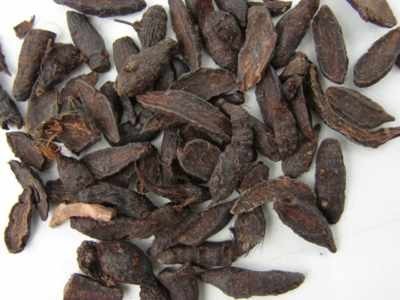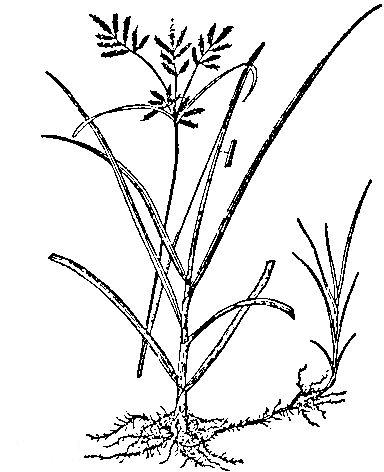 Cyperus
rotundus 香
附 Xiāng
fù Nut grass,
Chufa grass Family: Cyperaceae
Cyperus
rotundus 香
附 Xiāng
fù Nut grass,
Chufa grass Family: Cyperaceae
The names "nut grass" and "nut sedge" – shared with the
related species Cyperus esculentus – are derived from its tubers,
which resemble nuts.
FLAVOR:
Pungent, Slightly bitter, Slightly sweet, acrid, fragrant CHANNELS:
Liver, Triple Heater
FUNCTIONS- This is the main gynaecological herb in blood disease.[3]
King herb for Qi disease, especially for gynecological symptoms. Widely used
for pain associated with Liver Qi stasis.[3]
GROUP:
Regulating Qi
1. Dissolve Energy congestion.[1,2]
2. Regulate menstruation-[1]
if due to Qi disorder.[3] Alleviates
pain.[1,2]
3. Strengthens the Stomach and relieves distension.
INDICATIONS
1. Pain due to Qi stasis: Chest pain.[1,2]
Rib Pain.[1,2,3] Abdominal
pains.[1,2] Liver Qi
stasis:[3] showing as pain
in ribs, eg chronic hepatitis (Yin jaundice), emotional stress, easily angered,
nervousness, hypertensive. Pain due to stasis in stomach area (around CV12)
with acid reflux, belching, lack of appetite- eg Stomach or duodenal ulcer,
chronic gastritis (Hot type). Stomach pains and nausea and vomiting.[1]
2. Menstrual irregularity.[1,2]
Dysmenorrhea-[1,2,3] with Qi
stasis in Liver, premenstrual tension and nervousness. Emotional stress.[3]
3. Traumatic injuries.[1]
CONTRAINDICATIONS: Deficiency Heat. Blood deficiency. Early
menstruation.[3]
PATENT COMBINATIONS
External attack of Wind Cold or Wind Heat with
headache: Releases Exterior Wind Cold and Wind Heat, relieves
headache Cnidium &
Tea- Chuan xiong cha tiao san.
Stagnation of Liver Qi: Spreads the Liver Qi and quickens
the Blood to alleviate pain. Bupleurum
& Cyperus- Chai hu shu gan wan.
Liver Qi stagnation: Spreads the Liver Qi and regulates
the Stomach Cyperus & Peony-
Shu gan wan.
Qi and Blood stagnation:
Quickens the Blood and dispels Blood stasis, regulates the Qi, alleviates
pain, nourishes the Blood Danggui
& Notoginseng- Tong jing wan.
Deficiency of the Stomach and Spleen with Stagnation of Dampness:
Tonifies the Qi, strengthens the Spleen and Stomach, transforms Phlegm and
Dampness, regulates the Qi and harmonizes the middle Heater, alleviates pain
Cyperus & Caramon- Xiang
sha yang wei wan.
PREPARATIONS: Decoction.
Rhizomes 7-14 g. For external use, an appropriate amount of the
fresh material may be crushed for applying on affected parts.[1]
9-15 g.[1] 4-9 g.[2,3]

HABITAT: Found growing wild on hillsides and roadsides.
DESCRIPTION: Perennial herb 30-60 cm in height. Rhizome: creeping, apex a fat and thick spindle-shaped tuber, Culm erect, 3-angled. Leaves: linear, fine, with parallel venation, apexes acute, margins intact. Flowers: in summer, terminal brown flowers form compound spike inflorescences. Achene: 3 angled.
References
Inner Path can not take any responsibility for any adverse effects from the use of plants. Always seek advice from a professional before using a plant medicinally.

Research
Antidiabetic activity of ethanolic extract of Cyperus rotundus rhizomes
in streptozotocin-induced diabetic mice
Pradeep Singh, Ratan L Khosa, Garima Mishra, Keshri K Jha
Objective: In the present investigation, ethanolic extract of Cyperus rotundus
(EECR) rhizomes was evaluated for antidiabetic activity in streptozotocin
(STZ)-induced diabetic swiss mice. Materials and Methods: After administration
of EECR extract for 3 weeks, the body weight, blood glucose, biomarker enzymes
(serum glutamic pyruvic transaminase [SGPT] and serum glutamic oxaloacetic
transaminase [SGOT]), and plasma lipid levels were measured in STZ-induced
diabetic mice. Results: The ethanolic extract at dose levels of 250 and 500
mg/kg body weight revealed significant antidiabetic activity, improvement
in body weight, and reduction in elevated biochemical parameters such as SGPT,
SGOT, cholesterol, and triglyceride levels. Conclusion: These experimental
findings seemed to indicate the use of this plant in traditional Indian medicine
for the treatment of diabetes.
J Pharm Bioall Sci 2015;7:289-92 jpbsonline.org
DOI: 10.4103/0975-7406.168028